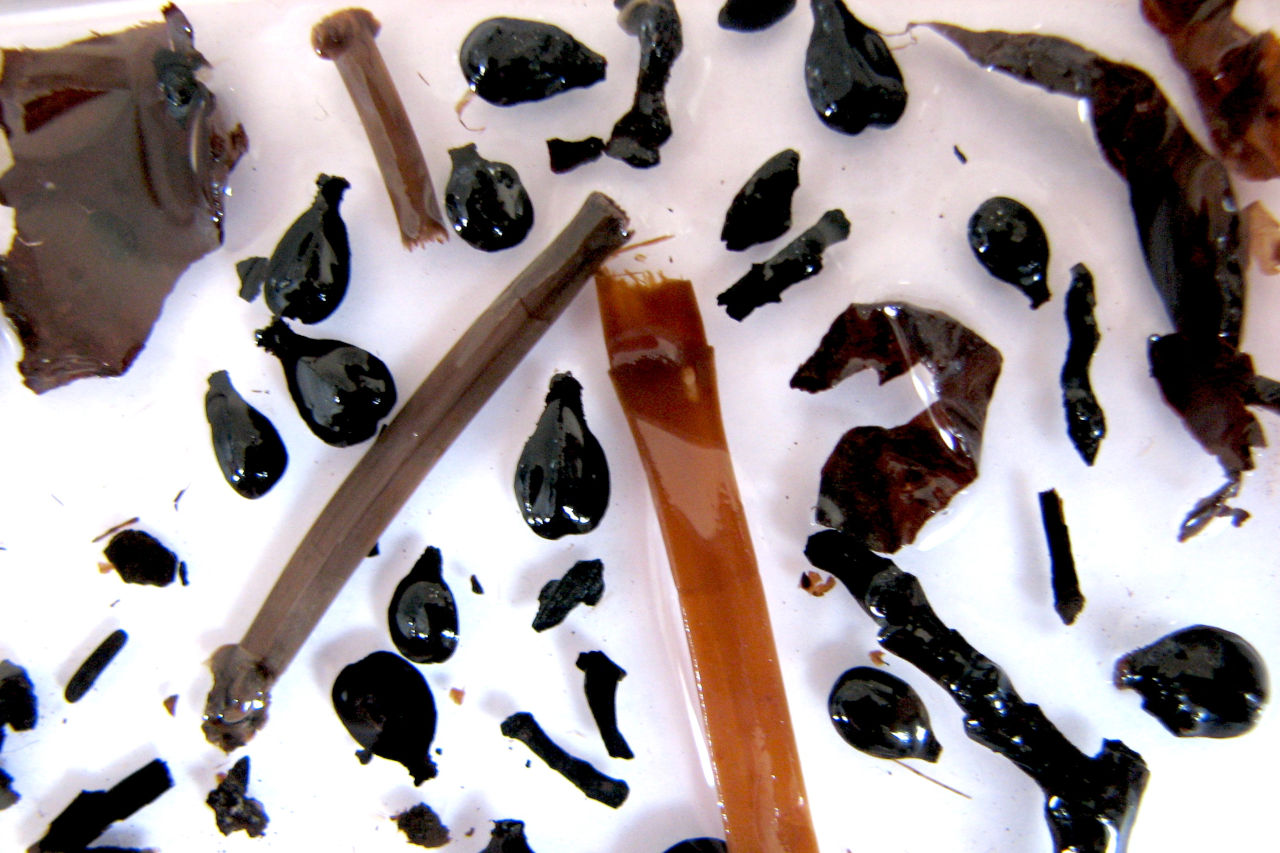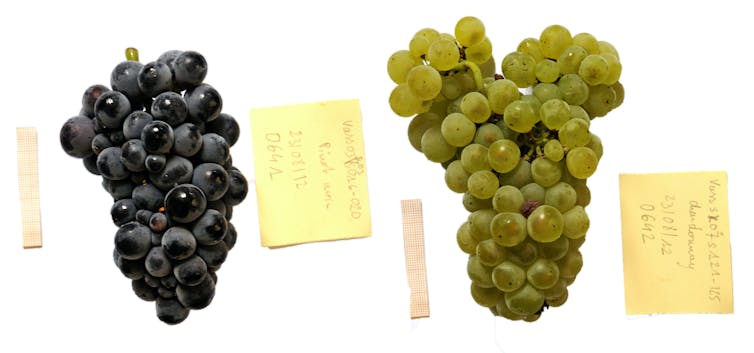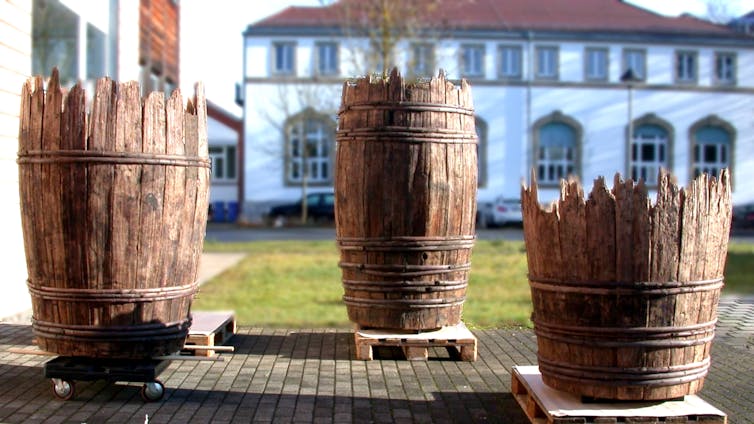Archaeological seeds shed light on Champagne's winegrowing history
The Champagne region is synonymous with... champagne. A symbol, even synonymous with celebration and luxury, the reputation of this sparkling wine is well established.
Vincent Bonhomme, University of Montpellier

site at Troyes "Place de la Libération" in the Aube. The plant remains were
preserved waterlogged as they came from the base of a well. Grape seeds, pedicels, stalk fragments and leaf blade fragments can be seen.
Véronique Zech- Matterne, CC BY-SA
In the 17th century, its presumed inventor, the cellarer monk Dom Pérignon, is said to have told his brother monks after his first tasting: "Come quickly, I'm tasting the stars". These famous bubbles are induced by "prise de mousse", the controlled transformation of a still wine into an effervescent wine.
The modern history of champagne is well documented. But what did people drink in Champagne before it was invented? In a study published in Scientific Reports, a team of researchers, including myself, use an exceptional series of archaeological pips to shed light on fifteen centuries of viticulture in the Champagne region, before the appearance of champagne.
15 centuries of seeds
The "viniculture" scientific project, coordinated by theInstitut des sciences de l'évolution in Montpellier (ISEM), combines archaeoscientific approaches to better understand the history of French viticulture and viniculture, from their very origins.
In this context, our team, which studies the biological and cultural histories of domesticated species, had access to a series of 572 grape seeds, dating from the1st to the 15th centuries AD. Since then, they have been immersed in water and uncovered by archaeological colleagues during preventive archaeology research prior to development work in Reims and Troyes.
Tracing the history of vines
To understand what this means, let's remember that the vine is a domesticated species. In other words, humans largely control its reproduction, taking it out of purely "natural" selection, to improve it, more or less consciously, according to their own selection criteria.
From wolves to Yorkies, the diversity of shapes induced by domestication and subsequent selection is obvious. The shape of organisms is a focal point of many disciplines, particularly botany and archaeology.
At the crossroads of these two disciplines, archaeobotany studies plant biological remains, to better understand the history of plants consumed by past societies. Shape is often the only data that can be used, although ancient DNA can sometimes be exploited.
Wild and domestic vines
Mathematically, shape is that which remains "invariant to translation, rotation and isotropic deformation". In other words, "all squares have the same shape, but not all triangles".
Let's take a look at the shape of the seeds in today's grapevine. Those of the wild vine, now endangered, have a rounded shape with a faint "beak". On the other hand, those of the domesticated vine, grown for table or vat use, are elongated, with a rather pronounced beak. And within the domestic vine, the shape of the seeds of the different varieties also differs.

Sarah Ivorra
This variability, also present on archaeological seeds, can be exploited to probe the history of viticulture. In the archaeobotanical register, we find differences between elongated and rounder seeds.
To measure roundness, elongation - in short, the morphological characteristics of the seeds - we adopt both a mathematical and statistical approach.
From the seeds - modern or archaeological - we determine whether the vine that produced them was a wild vine or a domestic variety and, in the latter case, its historical-geographical origins.
A digital signature for every problem
How do we go about it?
Each archaeological seed, previously dated, is photographed individually, from the front and in profile. The coordinates of their silhouettes are extracted, and these geometries are converted into quantitative variables using appropriate mathematical transformations.
These shape variables have the advantage of capturing all morphological information, without any preconceived ideas about what we're looking for - not just stature or stoutness. This is a major advantage, as the differences are so subtle that we don't know in advance which direction to look.
The "actualist" approach and its limits
Now that archaeological seeds have been converted into digital morphological signatures, they are compared with those of modern seed collections, made up of domestic and wild varieties taken from their habitat.
Within each archaeological assemblage (from the same period and the same site), we compare the populations of forms observed with those in our modern collections: we then derive the proportions of wild vine to domestic vine, as well as the geographical affinities (rather southern or northern) of each seed for each site, and over time.
This approach is known as "actualist": current diversity can shed light on past diversity. But it's not enough!
Firstly, centuries may have altered the initial shape of the seed. Secondly, morphological resemblance does not guarantee biological identity: an archaeological seed similar to that of a present-day pinot noir does not guarantee kinship. What's more, the absence of archaeological data from a site at a given period does not necessarily mean that there was no viticulture. Finally, even when archaeological material is found, it is always in limited quantities and we have to make do with it. For example, our 15-century series shows 7 centuries without any data.
However, the description of the shape provides a powerful insight into the history of domesticated plants.
Viticultural innovation in the Gallo-Roman period
Let's now apply this approach to our archaeological seeds from Champagne. Based on the series available to us, we have been able to shed light on two major historical phases.
Some of the seeds date from the Gallo-Roman period, i.e. the first three centuries AD. This is followed by a gap of seven centuries. Then another five centuries, from the year 1000 to the end of the Middle Ages.
In the Gallo-Roman period, both wild and domestic seeds were used. In fact, the use of wild grapevines is historically attested at this time in southern Gaul. As the domestic varieties used in the Champagne region were of southern affinity, it is possible that they were the same as those developed and used much further south.
Studies using ancient DNA also reveal the concomitant presence of the same genetic individuals in southern and northern Gaul. The mild climate of the time undoubtedly favored these varietal migrations.
Morphological diversity also increased during this period, suggesting that cultivated varietal diversity also increased, and suggesting the deployment of viticultural experiments.
In the Middle Ages, the persistence of wild vines, an echo of climate and past societies
Let's move on to the second historical period concerned, which begins around the year 1000. Although grape varieties had already been available for at least a millennium, the presence of wild-type pips was nevertheless observed, sometimes even predominating in some of these blends.
To explain this, we hypothesize that wild populations were used during the "medieval agricultural revolution", a period of intense economic and social change.

Philippe Rollet
As in the first centuries of our era, domestic types also show southern affinities. Here too, these results correlate with the climate of the time, known as the "medieval climatic optimum": a warming of a few tenths of a degree that affected Western Europe for several centuries. Such conditions seem to have played a decisive role in the history of grape and wine growing in Champagne and other wine-growing regions.
This period was followed by the "Little Ice Age", with the first archaeological discoveries of cold-weather types typical of the Burgundy and Champagne regions, just over two centuries before the invention of champagne.
These results shed new light on Champagne's winegrowing history, highlighting hitherto unsuspected varietal dynamics and their close links with historical events and past climatic changes.![]()
Vincent Bonhomme, Researcher in evolutionary biology, University of Montpellier
This article is republished from The Conversation under a Creative Commons license. Read theoriginal article.